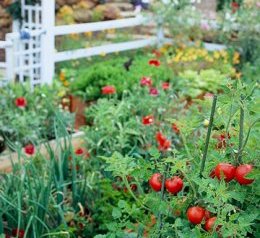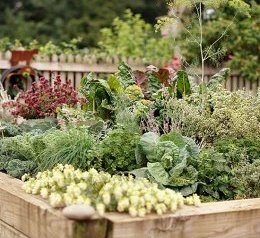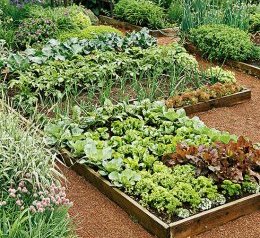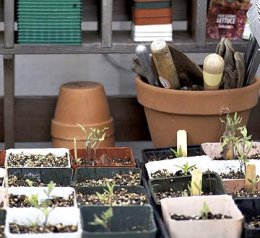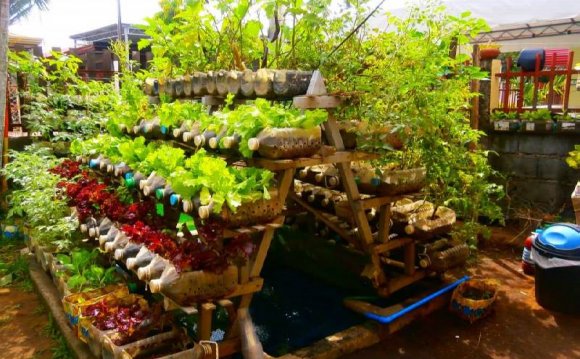

Deciding What to Plant in a Garden with Vegetables
At first, when deciding what to plant in a garden with vegetables, it's best to start small. Many gardeners get a little too excited at the beginning of the season and plant more than they need - and end up wasting food and feeling overwhelmed by their garden.
So first, take a look at how much your family will eat when you think about how to plan a vegetable garden. Keep in mind that vegetables such as tomatoes, peppers, and squash keep providing throughout the season - so you may not need many plants to serve your needs. Other vegetables, such as carrots, radishes, and corn, produce only once. You may need to plant more of these.
Determining How Much Space You Need
Once you know what you want to plant, you can figure out how plan a vegetable garden with the right amount of space.
Keep in mind when figuring out what to plant in a garden with vegetables that you don't need a large space to begin. If you choose to grow in containers, you don't even need a yard - a deck or balcony may provide plenty of space.
In fact, a well-tended 10x10-foot vegetable garden will usually produce more than a weed-filled or disease-ridden 25x50-foot bed.
Picking the Perfect Spot
No matter how big your vegetable garden is, or how you determine what to plant in a garden, there are three basic requirements for success:
1. Full sun. Most vegetables need at least 6-8 hours of direct sun. If they don't get enough light, they won't bear as much and they'll be more susceptible to attack from insects or diseases.
Here's a hint: If you don't have a spot in full sun to plant a garden with vegetables, you can still grow many leafy vegetables such as lettuce and spinach. And if you're in a hot-summer climate, cool-season varieties such as peas may do better in part shade.
2. Plenty of water. Because most vegetables aren't very drought tolerant, you'll need to give them a drink during dry spells. When thinking about how to plan a vegetable garden, remember: The closer your garden is to a source of water, the easier it will be for you.
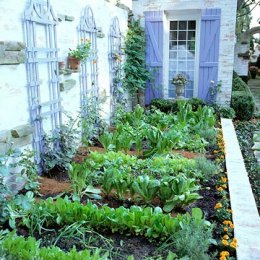 3. Good soil. As with any kind of garden, success usually starts with the soil. Most vegetables do best in moist, well-drained soil that's rich in organic matter (such as compost or peat moss).
3. Good soil. As with any kind of garden, success usually starts with the soil. Most vegetables do best in moist, well-drained soil that's rich in organic matter (such as compost or peat moss).
Many gardeners like to have their vegetable gardens close to the house. This makes it easier to harvest fresh produce while you're cooking. It can also be handy to keep a few favorite potted vegetables next to your grill.
How to Design and Plan Your Vegetable Garden
There are two basic approaches to planning the layout of a vegetable garden:
Row Cropping
This is probably what comes to mind when you think of what to plant in a garden with vegetables: You place plants single file in rows, with a walking path between each row.
The downside of row cropping is that you don't get as many vegetables in a small space, as much of the soil is used for footpaths rather than vegetable plants.
Row cropping isn't as visually interesting, either.
Here's a hint: Allow at least 18 inches between your rows so you have plenty of room to work between them. And as you sketch out your plan, place taller vegetables at the north side of the garden. This includes naturally tall plants - like tomatoes - and plants that can be grown on vertical supports - including snap peas, cucumbers, and pole beans.
Intensive Cropping
This type of planting a garden with vegetables means using in wide bands, generally 1-4 feet across and as long as you like. Intensive cropping reduces the amount of area needed for paths, but the closer spacing of the plants usually means you have to weed by hand.
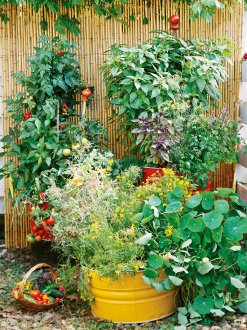 Because of the handwork required, when thinking how to plan a vegetable garden with rows remember: It is important not to make the bands wider than you can comfortably reach.
Because of the handwork required, when thinking how to plan a vegetable garden with rows remember: It is important not to make the bands wider than you can comfortably reach.
Intensive cropping also allows you to design your vegetable garden, making it a good choice, for example, if you want to grow vegetables in your front yard. It's a great solution for mixing vegetables with ornamentals, as well.
A specialized version of intensive cropping is the "square-foot method." This system divides the garden into small beds (typically 4x4 feet), that are further subdivided into 1-foot squares. Each 1-foot square is planted with one, four, nine, or 16 plants, depending on the size of the plant when it matures.
It also makes sense to leave some areas of the garden unplanted at first. This allows you to plant a second crop to harvest later in the season. Lettuce, radishes, green onions, carrots, and bush beans are commonly planted several times during the season.
Don't miss these other vegetable-garden design tips!
Testing and Fixing Your Soil
It's best to test the soil before you begin planting a garden with vegetables. Check drainage by soaking the soil with a hose, waiting a day, then digging up a handful of soil. Squeeze the soil hard. If water streams out, you'll probably want to add compost or organic matter to improve the drainage.
Next, open your hand.
If the soil hasn't formed a ball, or if the ball falls apart at the slightest touch, the soil is probably too sandy. (Add organic matter to improve sandy soil.)
If the ball holds together even if you poke it fairly hard, you have too much clay in your soil. (Organic matter improves clay soil, too.)
But if the ball breaks into crumbs when you poke it - like a chocolate cake - rejoice! Your soil is ideal.
If your soil doesn't drain well, your best bet will probably be to install raised beds.
Here's a hint: Build raised beds on existing lawn by lining the bottom of frames with several layers of newspaper, then filling with soil. That way, you don't have to dig!
Digging Your Beds
Loosen your soil before you plant a garden with vegetables. You can either use a tiller or dig by hand.
Once the soil has been loosened, spread out soil amendments (such as compost) and work them into the soil. Avoid stepping on freshly tilled soil as much as possible. Otherwise, you'll be compacting the soil and undoing all your hard work.
When you're done digging, smooth the surface with a rake, then water thoroughly. Allow the bed to rest for several days before you plant.
Choosing Varieties
Once you start deciding what to plant in a garden with vegetables, you'll probably notice that the possibilities for are endless. There are thousands of tomato varieties alone!
When selecting varieties, pay close attention to the description on the tag or in the catalog. Each variety will be a little different: Some produce smaller plants that are ideal for small gardens or containers, others offer great disease resistance, improved yields, better heat- or cold-tolerance, or other features.
Seed catalogs are one of the best sources for vegetables. Once you narrow your choices to types of vegetables, pick two or three varieties that seem promising. That way if one variety doesn't perform well, you'll have other plants to make up for it. Next year, grow the best performer again, and choose another to try.
